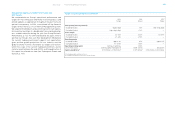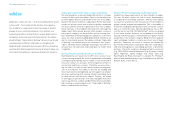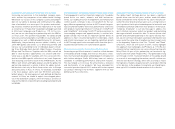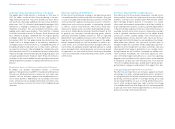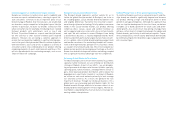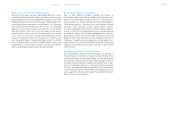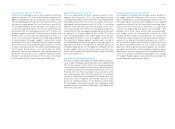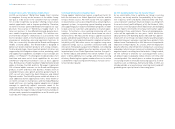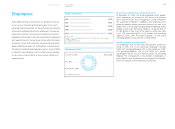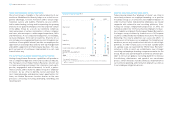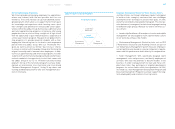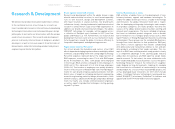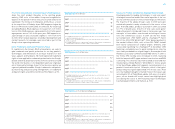Reebok 2006 Annual Report Download - page 65
Download and view the complete annual report
Please find page 65 of the 2006 Reebok annual report below. You can navigate through the pages in the report by either clicking on the pages listed below, or by using the keyword search tool below to find specific information within the annual report.061
Corporate Functions ›» Global Operations
Asia Dominates Footwear Production
In 2006, Asia continued to be our most significant sourcing
region for footwear. 97% of our total footwear volume for the
adidas and Reebok brands was produced in this region (2005:
95% excluding Reebok). Production in Europe (incl. Africa) and
the Americas represented 3% of our sourcing volume (2005:
5% excluding Reebok). China represents our largest source
country with approximately 46% of the total volume followed
by Vietnam with 25% and Indonesia with 23%. In 2006, our
footwear suppliers produced 199 million pairs of adidas and
Reebok shoes, up 62% from 123 million pairs in 2005 as a
result of the inclusion of Reebok and strong organic growth
at brand adidas. Although supplier concentration visibly
increased in 2006 due to the acquisition of Reebok, our larg-
est footwear factory only produced approximately 11% of our
footwear sourcing volume for the adidas and Reebok brands.
The Rockport brand, which is not serviced by our Global
Operations function due to different sourcing requirements in
the brown shoe business, has a separate operations team.
Rockport sourced approximately 10 million pairs of footwear
in 2006, primarily from China, Indonesia and Vietnam.
Apparel Production Driven by Asia
Asia also represented the most significant portion of our
apparel source base with 76% of our total apparel volume
coming from the region in 2006 (2005: 78% excluding Reebok),
followed by Europe (incl. Africa) with 16% (2005: 16% exclud-
ing Reebok) and the Americas with 8% (2005: 6% excluding
Reebok). China and Indonesia were the largest source coun-
tries, representing 23% and 15% of total apparel production,
respectively. In total, our suppliers produced 230 million units
of apparel for all Group brands in 2006 (2005: 177 million
units excluding Reebok). The largest apparel factory pro-
duced approximately 8% of our total apparel volume in 2006.
The majority of Reebok apparel volumes were sourced at
our independent manufacturing partners through agents as
opposed to the direct sourcing which is common practice at
the adidas Group. As part of the integration of Reebok into our
Group’s supply chain, we will build in-house sourcing capa-
bilities while steadily reducing the number of agents involved
in the sourcing process.
Brand-Specific Hardware Production
The bulk of adidas and Reebok branded hardware products,
such as balls and bags, were produced in Asia, representing
97% of the volume in 2006 (2005: 96% excluding Reebok).
China remained our largest source country, representing 61%
of hardware production, followed by Vietnam with 19% and
Pakistan with 14%. The remaining 6% was sourced via other
Asian and European countries. The majority of our hardware
volume at TaylorMade and Reebok-CCM Hockey was also
produced in Asia. In addition, both brands sourced a small
portion of hardware products in the Americas and Europe.
At TaylorMade, the majority of golf club components were
manufactured in China and assembled by TaylorMade in the
USA, China and Japan.
Reebok Integration Drives Cost Savings
The integration of Reebok has brought several benefits to
our supply chain. Our integration efforts focus on maximiz-
ing our buying power, consolidating global contracts with our
third party logistics providers and building in-house apparel
capabilities at Reebok. In 2006, we established a new Global
Logistics function to work across all brands as a single point
of contact for negotiating with global service providers. One
example of this team’s early success was achieving signifi-
cant savings across our transportation contracts for 2006
and beyond. With respect to buying power, we initiated our
“World Class Buyer” program to maximize purchasing lever-
age across our brands. Consolidating volume across our first
and second tier suppliers and adopting costing best practices
will be the two primary drivers of cost savings in our Global
Operations function going forward. In apparel, we will lever-
age adidas best practices and technologies to build in-house
development and sourcing capabilities for Reebok. The busi-
ness has so far been channeled through agents. This change
will support Reebok apparel sales growth by ensuring more
reliable deliveries and consistent quality.


